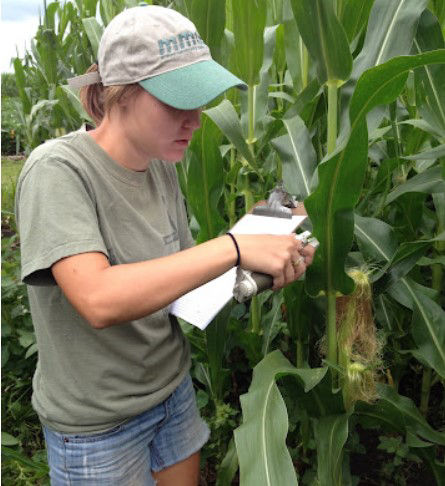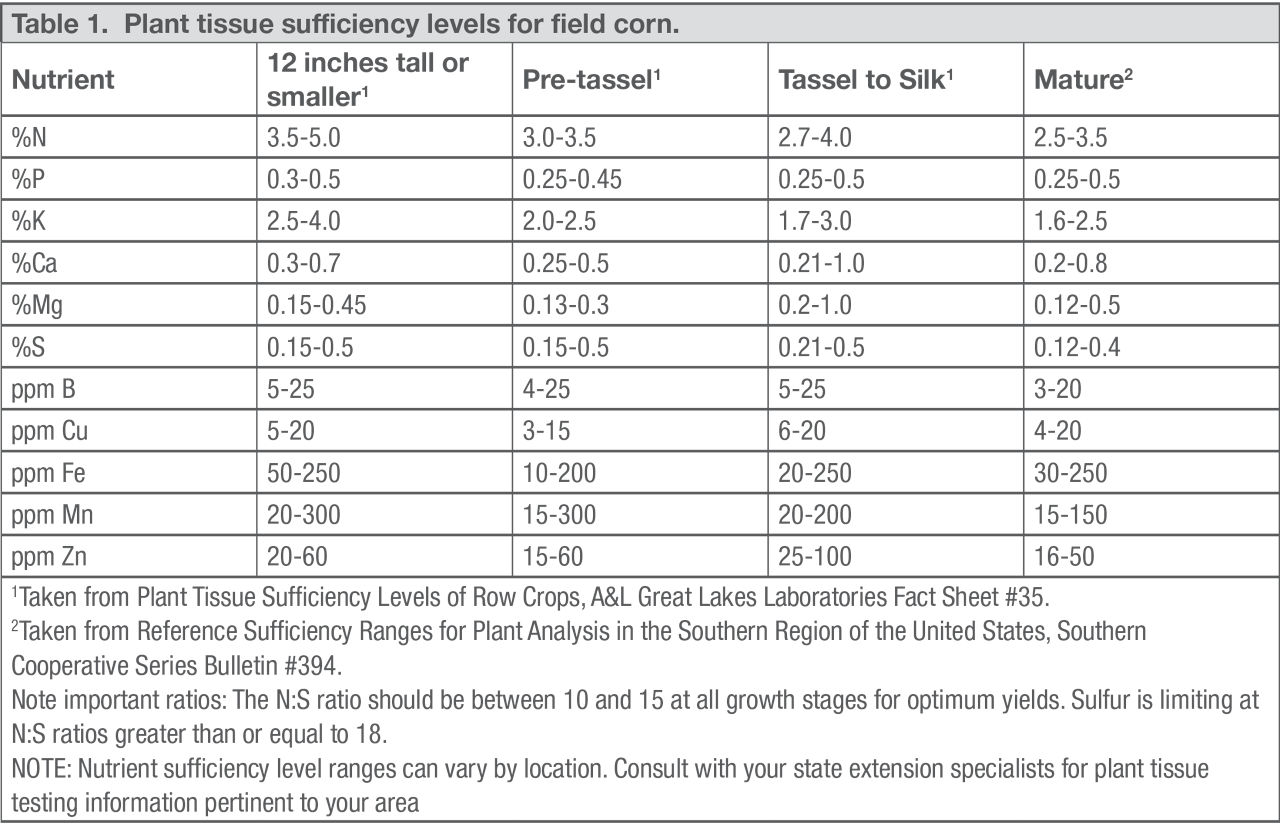3 MIN READ
Conducting Tissue Testing in Corn
August 27, 2023
Q. Why should growers consider tissue testing their corn?
Growers are increasingly using plant tissue testing to maximize yield potential. Along with soil testing, tissue testing is a tool that can help growers determine the effectiveness of their fertility programs. Tissue testing an actively growing corn plant provides a snapshot of the plant’s nutrient content at the time of sampling. The benefits of knowing a plant’s nutrient content include:
- Diagnosing a suspected nutrient deficiency or revealing hidden nutrient stresses
- Identifying and monitoring how well plants utilize soil nutrients and applied nutrients
- Checking the effectiveness of fertility programs
- Helping growers make more informed decisions on the need for sidedress and foliar nutrient applications
- Helping growers determine future fertilizer needs
- Helping growers improve yield goals
Plant tissue testing can be used to improve your fertility program and help push corn yields to the next level. However, tissue testing alone is not a better diagnostic tool than soil testing. Plant tissue testing should only be used to compliment widespread soil testing, not as a substitute for soil testing. Tissue testing can be most useful when a field has areas of plants that look normal and areas of plants with poor growth or symptoms that could indicate nutrient deficiency. Plant tissue testing and soil testing should both be conducted in normal growth areas and poor growth areas to best understand the situation. Fertility plans are best made with the use of a combination of soil testing and plant tissue testing.

Q. When should you conduct plant tissue testing?
Sampling can be conducted early in the season or later in the season, depending on the grower’s goals. Early samples can be collected while there is still time to apply nutrients to the current year’s crop. Late season samples can be used to help evaluate the current crop and to adjust nutrient plans for the next crop. Sampling throughout the growing season is recommended to monitor the crop’s nutrient status and to get the most benefit out of the testing. If a grower is interested in monitoring their crop through the entire growing season, corn tissue testing should be conducted three times: at the V4 or V5 growth stage, between V9 and V12 growth stages, and at tasseling or early R1 (silking). However, tissue samples can also be taken later, from the reproductive growth phases through harvest. Testing in early reproductive growth could reveal a treatable deficiency, whereas later tests could help with fine-tuning nutrient levels in preparation for next year’s crop.
Q. How should plant tissue samples be taken and prepared for testing?
Testing laboratories provide the specific materials and instructions for properly taking and shipping plant samples, but here is some general advice. For reliable results, tissue samples must be taken from a specific part of the plant at a given stage of growth.
- For corn up to 12 inches tall (V5 corn is generally 8 to 12 inches tall) – sample the entire plant above ground, cutting the stalk off about ½ inch above the ground level.
- For corn more than 12 inches tall prior to tasseling (V6 to V18 corn) – sample the first fully-developed leaf from the top (first leaf below the whorl), cutting the leaf at its base where it joins the sheath.
- For corn that has tasseled through corn that has reached reproductive growth (VT to R6 corn) – sample the leaf below the top ear, cutting the leaf at its base where it joins the sheath.
Samples should be collected from at least 20 randomly selected plants in the field or area to be tested, and then combined into one composite tissue sample. In problem fields where comparisons are needed, sets of 20 samples should be collected separately from both the affected plants and the adjacent normal plants at the same growth stage. Combining tissue testing with soil sampling in the same location can provide even more data on nutrient levels, which may allow a grower to make better decisions. If multiple samples are taken throughout the growing season, be consistent by sampling the same areas in the field at the same time of day every time you take samples.
To prepare tissue samples for testing, clean any samples that are contaminated with soil, fertilizer, or spray residues by lightly washing them with distilled water or following laboratory directions. Samples must be kept relatively fresh, so air-dried samples should be shipped to the testing laboratory as soon as possible. Samples can be placed in a refrigerator if shipping is delayed, but samples must never be frozen. To facilitate quick shipping and prevent transportation delays, it is recommended to take samples on a Monday morning and to ship them that afternoon or the next day. Avoid shipping samples on a Thursday or Friday, unless one-day delivery can be guaranteed. Test results should be back by the end of the week.
Q. How should you interpret plant tissue testing results?
Your plant tissue testing results can be compared to the nutrient sufficiency levels that have been established by research and surveys (Table 1). Sufficiency ranges are nutrient concentrations that are considered adequate for high yields. However, the ranges do not provide exact break points between a nutrient being sufficient, deficient, or toxic. A nutrient level test result should be evaluated to where it is positioned relative to the middle of the established sufficiency range. If the result is close to the low end of the range, there is a greater chance of crop response to an additional amount of that nutrient. If the result is close to the high end of the sufficiency range, adding more of the nutrient probably would not benefit the crop. Laboratory reports generally indicate whether each tested nutrient level is deficient, low, sufficient, high, or very high for the crop at the sampled growth stage.
To avoid errors in interpreting results, use caution when evaluating a tissue test report. It is important to understand that crop nutrient levels vary during the growing season, and that nutrient uptake can be influenced by location, corn product, and soil nutrient levels. Stress caused by drought, excess moisture, pests, diseases, or severe deficiency of other untested nutrients can influence the growth of plants and their uptake of the tested nutrients. These factors should be considered when interpreting plant tissue test results. Therefore, it is often best to compare the results of multiple tissue tests taken across a growing season, and to interpret the results based on the trends for a given nutrient.
Q. Does drought impact tissue test results?
Caution should be used when interpreting tissue test results during drought conditions. Depending on the nutrient, a drought (or certain diseases) can alter nutrient uptake by either increasing nutrient accumulation within a plant or decreasing the concentration present by diluting it with dry matter.
During drought, K deficiency symptoms become obvious in the lower leaves. While the symptoms may mark a “real” soil deficiency, they may also be the result of the K uptake process’s high sensitivity to limited soil moisture. Adding K as either a soil or foliar applied application will not alleviate the symptoms, because the K is already present despite the plants’ lack of ability to uptake it from the soil due to the limited available moisture. When rain returns the symptoms will not appear on new growth if soil K is at the optimal range or higher.
Contact your local agronomist, trusted agronomic adviser, state extension office, or use laboratory services for recommendations and assistance when interpreting plant tissue test results.
Q. How should you use plant tissue testing results?
Knowing the nutrient status of your crop can help you make decisions about nutrient applications, such as nitrogen (N), potassium (K), phosphorus (P), or various micronutrients. Most micronutrient deficiencies and sulfur (S) deficiency can be more accurately identified by plant tissue tests than by soil tests. The results from testing done prior to sidedressing and corn silking can be used to adjust sidedress applications and foliar-fed nutrients. The best timing for foliar fertilizer applications is around the yield-determining growth stages of V4 to V12, and tassel initiation in the whorl. The results from tissue tests done around these intervals can be used to help growers make more informed decisions about fertilizer applications in the current crop and the next crop. If a nutrient application is needed to address a deficiency, macronutrients—N, P, K, and S—are generally applied to the soil, and micronutrients—boron (B), zinc (Zn), iron (Fe), molybdenum (Mo), and manganese (Mn)—are usually applied to the leaves. Consult the appropriate herbicide labels for compatibility information before tank-mixing foliar nutrients with an herbicide.

Sources:
Schulte, E.E. and Kelling, K.A. Plant analysis: a diagnostic tool. National Corn Handbook. NCH-46. Crop Fertilization. Purdue University Cooperative Extension. https://www.extension.purdue.edu/extmedia/nch/nch-46.html
AgSource Laboratories. 2017. Tissue-sample to monitor crops throughout the season. FarmProgress. https://www.farmprogress.com/crops/tissue-sample-to-monitor-crops-throughout-the-season
Thom, W.O., Brown, J.R., and Plank, C.O. 1991. Sampling for corn plant tissue analysis. National Corn Handbook.NCH-15. Crop Fertilization. Iowa State University Extension. http://corn.agronomy.wisc.edu/Management/pdfs/NCH15.pdf
A & L Great Lakes Laboratories. 2016. Plant tissue sampling of row crops. Fact Sheet No. 34. https://cdn.shopify.com/s/files/1/0979/5626/files/FS34_-_Plant_Tissue_Sampling_of_Row_Crops_a8b14c10-968d-4dd0-b2ff-92de21f89aae.pdf?14027270015500806015
Campbell, C.R. and Plank, C.O. 2013. Reference sufficiency ranges for plant analysis in the southern region of the United States. Southern Cooperative Series Bulletin #394. North Carolina Department of Agriculture and Consumer Services Agronomic Division. www.ncagr.gov/agronomi/saaesd/scsb394.pdf.
Mallarino, A. and Sawyer, J. 2019. Tissue testing for field crops requires cautious use and interpretation. ICM News. Integrated Crop Management. Iowa State University. https://crops.extension.iastate.edu/cropnews/2019/06/tissue-testing-field-crops-requires-cautious-use-and-interpretation-0
Slaton, N., Norman, R., Roberts, T., Kelley, J., Hardke, J., Robertson, B., Ross, J., and Espinoza, L. 2016. Research lacking to back claims for foliar-applied fertilizers. University of Wisconsin Integrated Pest and Crop Management. https://ipcm.wisc.edu/blog/2016/06/research-lacking-to-back-claims-for-foliar-applied-fertilizers/
Laboski, C. 2016. Plant analysis are you using it and interpreting the results correctly? University of Wisconsin Integrated Pest and Crop Management. https://ipcm.wisc.edu/blog/2016/06/plant-analysis-are-you-using-it-and-interpreting-the-results-correctly/
Chakraborty, D. and Prasad, R. 2019. Phosphorus basics: deficiency symptoms, sufficiency ranges, and common sources. Crop Production. Extension. Alabama A & M & Auburn Universities. https://www.aces.edu/blog/topics/crop-production/phosphorus-basics-deficiency-symptoms-sufficiency-ranges-and-common-sources/
Muellar, N.D. and Ruiz Diaz, D.A. 2011. Micronutrients as starter and foliar application for corn and soybean. Proceedings of the 41st North Central Extension-Industry Soil Fertility Conference, Vol. 27, Des Moines, IA. https://www.extension.iastate.edu/Pages/eccrops/nceisfc11/8.pdf
Mallarino, A. 2023. Plant tissue testing may be useful this season but be aware of potential drought effects on the results. ICM News. Integrated Crop Management. Iowa State University. https://crops.extension.iastate.edu/cropnews/2023/06/plant-tissue-testing-may-be-useful-season-be-aware-potential-drought-effects
1213_133801